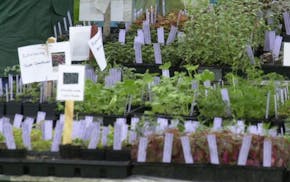Gardening, already one of the most popular hobbies in America, has experienced a huge growth spurt in the past five years.
Spending on gardening tools, plants and professional landscaping remains on the rise as more aspiring green thumbs seek to beautify their yards, connect to nature and grow produce to feed themselves.
If you've joined the green scene, you'll need a good garden center to sell you plants and educate you about how — and where — to grow them. The best nurseries boast a bounty of quality annuals and perennials. They'll also employ knowledgeable staff. But unfortunately, some garden centers offer lackluster goods and customer service.
To get to the root of it all, nonprofit Twin Cities Consumers' Checkbook collected opinions from local consumers on garden centers they've used. Checkbook also shopped for prices to see which stores will provide what you need for less green. Until June 5, Checkbook is offering free access to its ratings of area garden centers to readers via Checkbook.org/StarTribune/garden.
The opinions Checkbook collected reflect the big variation in quality among retailers. Some stores earned "superior" ratings overall by at least 80% of their surveyed customers, but several other retailers only garnered "superior" marks from fewer than 40%.
Checkbook's undercover shoppers checked prices at local independent shops and chains for 16 different plants, such as a lavender in a No. 1-size container, and a knockout rose in a No. 3 container. There were big price differences. For a boxwood in a No. 3 container, prices ranged from $23 to $60. A 2- to 3-foot dwarf lilac in a ball and burlap or a No. 2 container cost $25 to $60.
For the limited selection of plants they sell, Home Depot, Lowe's and Menards did very well on price. Menards' prices averaged 39% below the all-store average for comparable items. Home Depot's averaged 29% below, and Lowe's was 27% lower. Unfortunately, all three of these chains received low ratings for "quality of products" in Checkbook's survey.
Unlike most types of services and stores Checkbook evaluates, paying more for plants at garden centers does slightly improve your odds of receiving better advice, service and product quality.
Before shopping, make a plan. Consider your yard's soil type, acidity, drainage patterns and sunlight exposure. Match plant types with areas where they are likely to thrive. Your plan should show how your property will look right away, and how it will look years from now when your plants have grown.
Without a plan, you could wind up with an assortment of plants that do not complement each other in size, shape or color. You might end up with shade where you want sun and with the view from, or of, your house obscured. And you might pay for expensive plants when inexpensive ones would do just as well.
Seek advice from gardening websites, friends with attractive gardens and experts at local botanical gardens. If you want professional help, you have several options. A garden center or landscape contractor can send a designer to your place. And if you want to do your own buying and planting, you can pay a consultation fee for help preparing your own plan or a design fee if a designer draws the plan. Or use a free consultation by asking a nursery for a landscaping estimate.
You can also hire a landscape architect or garden designer to do everything, including consultation, design, assistance in selecting a contractor and supervision of plant selection and contractor performance. Or you can sign up only for the consultation or design. Your first conversation with an architect might be free; from then on, fees come in various ways.
When making plant purchases:
- Check roots to be sure they have not dried out. Probe with your finger or look through the drain holes of a container to make sure the roots are whitish, not brown.
- For shrubs and trees, check for weak or broken branches. Bark should not have scars or holes, and pruning cuts should be flush with the branch or trunk.
- Check plants for browned or grayed areas or spots on leaves or stems, all signs of disease. And check for insects.
- In growing season, be sure there is new growth.
- Get a receipt that shows the common and Latin names of plants as well as the size, number purchased, date of purchase, price and guarantee. You should also receive instructions on how and where to plant as well as pruning, feeding and spraying requirements.
- Ask for a guarantee. Fortunately, even though many plant deaths are the result of improper planting or care — in other words, the buyer's fault — Checkbook found that most garden centers nonetheless offer broad guarantees.
Twin Cities Consumers' Checkbook magazine and Checkbook.org is a nonprofit organization with a mission to help consumers get the best service and lowest prices. We are supported by consumers and take no money from the service providers we evaluate. You can access Checkbook's ratings of local garden centers until June 5 at Checkbook.org/StarTribune/garden.
Ramstad: Effort to change the ban on noncompetes emerges in the Legislature

Risk, return and time: Key variables in the money-managing equation

Spring means gardening: How to find affordable and quality plants

Want Johnny Cash's ring? A Minnesota company is auctioning off some of his prized possessions.

